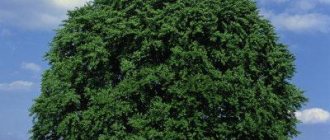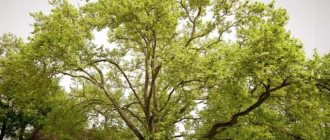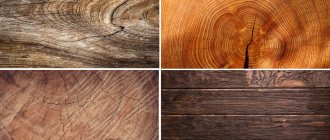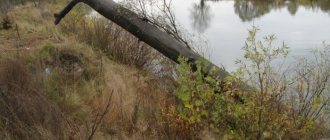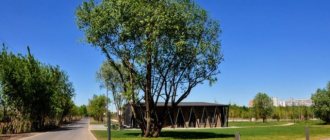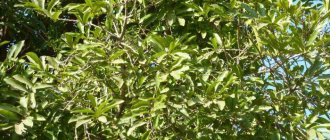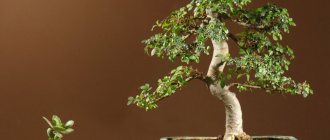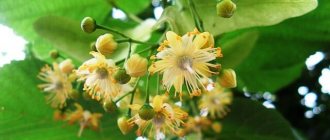In the modern world, it is important to use not only aesthetic materials, but also natural ones. Bog oak is just such a product. Combining aesthetics and naturalness, it has become widely popular. Of course, this raw material is expensive, but for those who cannot afford this material, but really want it, there are options. There are a number of different stylizations for this shade.
In many European countries, the discovery of such wood in nature is an event. And in Russia to this day large reserves of valuable wood have been preserved.
Unique characteristics
The oak lives its first life on the shore, the second in the water. The priceless wood is environmentally friendly - it got into the water in the pre-industrial period. After spending at least 300 years under water, bog oak acquires silver and fawn shades. And after 1000 years, the wood becomes almost black, although there are specimens with a purple tint, which allows the products to look even more original. This occurs due to the lack of oxygen supply due to the layer of sand and silt under which the tree rests, and high pressure. At this time, special chemical reactions take place and a natural preservative, tannin, is produced. Oak acquires amazing properties - it becomes hard, almost like stone and resistant to rotting and drying out, and no varnishes or paints are used in the manufacture of products - its texture and color are perfect.
Material extraction
The extraction of bog oak in large quantities today is only possible in Russia, Belarus and Ukraine. “Ironwood,” as it was called in the old days, is mined from the bottom of reservoirs during the minimum water level in the river. To search for precious material, the area is explored over many kilometers. In places where its deposits are supposedly located in the water, scuba divers begin working. They have to manually feel each trunk.
Each trunk is lifted ashore using modern technology. The weight of the tree can reach 50 tons. After lifting, the material is moved to the crosscutting area, its condition is assessed and processing begins immediately. After such “re-preservation” it can deteriorate in a fairly short period.
Artificial staining of oak
There are instructions on the Internet on how to make bog oak with your own hands using ammonia. But freshly cut oaks differ significantly in their qualities from those that have lain under water for centuries. When processing at home, there is a high risk that the wood will “lead”, so you need to be extremely careful with finished products.
Suppliers who use artificial staining claim high physical and mechanical properties of the material and guarantee ideal colors. The cost of such material differs slightly. But, in fact, the quality of such material is noticeably lower. No matter what technologies they use to stain a tree, it will never acquire the same qualities as a natural fossil oak that has undergone natural transformation processes. Only a specialist can distinguish real staining from artificial staining, which is what unscrupulous sellers take advantage of, greatly inflating prices for “fake” products.
Main processing steps
We will tell you in more detail how oak is dried in various ways. The technology is followed step by step and skipping one of the stages is unacceptable. Otherwise, the wood will crack and become brittle.
Vacuum effect
Vacuum drying of oak is carried out in special chambers, where excess moisture is drawn out of the wood under the influence of low atmospheric pressure. It takes place in several stages:
- Bog oak is soaked in an antiseptic solution for 2–3 hours. Sanezh will do.
- The product is placed in a drying chamber, where it is kept at a temperature of 25 degrees and a humidity of 50% for 5 to 10 days. Temperature and humidity must be constant.
- The oak is placed in a sealed chamber, where, under the influence of a vacuum, it is treated a second time with an antiseptic solution.
- Dries at a temperature of 35 degrees and humidity not higher than 25% for 10 days.
The method has advantages:
- Oak wood dries to a predetermined temperature.
- Only 2-7% color change.
- Fully ready within 4-5 weeks.
The disadvantages include high energy costs and the complexity of the process. If you do not monitor humidity or temperature, the wood will crack and become unusable.
Pulse method
The pulse method of drying bog oak is rarely used in Russia due to high costs. But it is considered effective and the material dries evenly.
Performed in the following steps:
- Conductors are connected to the wooden blank on both sides.
- The second ends of the conductors are connected to a special electrical appliance that will supply current.
- Under the influence of electrical impulses, the workpiece gradually dries to the required humidity.
If you have the skills and knowledge, then you can assemble such a device with your own hands and use it for work.
Adsorption method
The adsorption method resembles the old one and is available to everyone at home. To dry, a small piece of oak is placed in a material that absorbs moisture as much as possible. Craftsmen use special mineral granules. But newsprint will do.
Drying is performed in the following steps:
- Small pieces are soaked in a container with an antiseptic solution for 3–4 hours. But you should not use solutions with bleaching effects, otherwise the black color of the valuable breed will disappear.
- The workpiece is wrapped in several layers of paper and placed in a well-ventilated and dry place.
- Every day the product is unrolled and folded into new sheets of newspaper.
Drying is carried out for 1–2 months. The wood will not crack and will retain its noble shade.
Infrared plates
Infrared light heats the wood evenly and drys it gently. The workpiece does not heat up and no internal deformation is observed. The method is available in enterprises and at home. It is enough to purchase several infrared heating elements and place them on a frame made of timber or metal.
Drying is carried out in the following stages:
- The workpiece is soaked in an antiseptic solution for 3–4 hours.
- Place on a flat surface under infrared heaters.
- Once an hour, the workpieces should be turned over so that the heat is distributed evenly.
Humidity is checked using a hand-held moisture meter. When the product dries, it is allowed to rest for 3–4 days in a dark and cool place with a humidity of 15–25%. Then use it for its intended purpose.
The advantages of drying under infrared plates include:
- The wood does not deform or crack.
- Does not lose its black color.
- Drying occurs evenly over the entire depth and length.
- Electricity costs are minimal.
The method has no disadvantages, but due to its novelty it is little trusted. The video below details one of the available methods for drying hardwood:
How to properly dry bog oak is the secret of woodcarving masters. It was passed from father to son and carefully preserved. But with the advent of new technologies, it is not difficult to dry stained wood at home. The main thing is to follow technology and adhere to our instructions.
Bog oak is an excellent building material. Its unusual color is very popular. Therefore, it is widely applicable, especially for the production of finishing building materials and furniture fittings. It is also used to make various design and household items. For example, from a block of bog oak you can make a knife handle, a box, a photo frame and much more.
At home, excellent stained oak can be obtained, for example, from a block of ordinary oak.
To do this, we need a simple glass jar: liter or three liter - it all depends on the size of the piece of wood. You will also need simple shoe nails. And also a plastic lid for a jar, a hammer, a pharmaceutical solution of ammonia 10%, thin fishing line, and stationery tape. And, of course, our oak material.
This procedure is best carried out in a well-ventilated area or outdoors.
To begin with, you need to hammer a nail in any place on the block that is not important for aesthetic use in the future. A short length of fishing line should be tied to it.
Pour the ammonia solution into the jar as quickly as possible. Then you should lower the oak block into the jar, but so that it does not touch the ammonia solution itself. The ends of the fishing line, which is tied to the nail, must be brought out beyond the edges of the can opening. Then, very quickly put the plastic lid on the jar. In this case, the lid will press the fishing line, and the block of wood will hang in the jar without touching the ammonia solution, as required by the technology.
Using stationery tape, glue the fishing line from the outside to the surface of the jar. Also tape the lid and jar where they meet to prevent even the slightest ammonia evaporation.
In this position, the jar with the oak block should be left for one or three days. It all depends on how light or dark the color of the wood we want to get.
When opening the can, you should be extremely careful and try not to inhale ammonia fumes, as this can be hazardous to health.
If you keep a block of oak in a jar for more than three days, you will get a fairly dark color of stained oak. Because ammonia vapors reacted with tannins for quite a long time. And the longer this happens, the more saturated the color. In this case, the depth of wood impregnation will be up to 1 cm or more.
If it is possible to use fairly large glass containers at home, then in this way you can get a fairly decent amount of bog oak. Subsequently, bog oak can be used for construction purposes on a summer cottage. It will look especially beautiful after opening it with furniture varnish.
Using bog oak
In order to create products from bog oak, it must be properly dried and stored. International and state standards for ordinary wood are not suitable for bog oak. Special requirements affect its cost. Properly soaked and dried bog oak is expensive, which reduces the demand for it. Unfortunately, illiterate miners of this value, neglecting all the rules, throw the trunks in the sun or leave them in open-air areas for the winter, store them on barges, etc. As a result, most of the material becomes unusable and is used for firewood, and the remainder, which can be used elsewhere, is sold at a low price.
In the 90s, there were many cases when hundreds of cubic meters of bog oak were lifted from the water, sent wet abroad by wagons, and as a result it went into the furnace, because... upon arrival was not suitable for manufacturing products. Because of this, Western investors have lost interest in running such a business for a long time. Sometimes some of the raised trunks were thrown back into the reservoir. It is extremely difficult to return such material to normal condition when re-lifted.
Even in our time, there are very few specialists who can properly process wood. But if no mistakes are made, products made from bog oak truly become masterpieces of art in the hands of skilled craftsmen. For centuries, stunning and unique things were created from it - a variety of furniture, boxes, caskets and figurines - and was called “black gold”. Wealthy people could even afford parquet flooring for exorbitant amounts of money. Carving on bog oak was trusted only to trusted “blacksmiths”. Oak sets adorned the best houses, and men walked pompously with pipes made from this tree. Making it into veneer or covering it with varnishes, plastics and synthetic resins is absurd.
Bog oak is a valuable material that cannot be replenished, like any fossil. Hundreds of years must pass for new specimens to appear. But they will no longer be environmentally friendly due to environmental pollution. A thoughtless, superficial attitude towards the material leads to a reduction in stocks, but for now there is time to purchase products from centuries-old trees. They will serve more than one generation and will inspire awe among true connoisseurs of the natural beauty that nature has created.
Bog oak as a material for creativity
I present to your attention a creative material that many are not yet familiar with - bog oak.
Bog oak is usually called a tree that, for a number of reasons, in its natural form ended up in an aqueous, oxygen-free environment and remained in this “new life” for a long time until it was removed back from the water or peat bog, or sand quarry from great depths.
During long staining, the oak takes on a different color, becoming blue-black with a violet tint and barely noticeable silver veins. Popularly this color is called “crow’s wing” or “anthracite”.
Origin of bog oak.
Bog oak is a unique material that nature spent thousands of years creating; it is mined from the depths of rivers and swamps, in places where oak grew many thousands of years ago. By the will of fate, he did not die in forest fires and was not overcome by disease. As a result of a change in the river bed, the oak tree found itself under a layer of water, where, due to the presence of certain chemical elements in its composition that made it possible to preserve the integrity of the wood, it lived for a huge period of time. And despite the many trials that befell him, he not only survived to this day, but also acquired a number of unique properties and features unique to him. Each bog oak has gone through its own individual, centuries-old path. Therefore, each copy is unique and unrepeatable.
The poison phenol and chemical compounds of tanning oils come out along with water, the texture of the wood becomes denser. Wood after water does not need to be treated with anything, since it has no value for parasites, which is a huge plus. Also, if during life the tree was sick, then a very fast and irreversible process will occur at the bottom of the river, the wood will simply turn into dust, and a healthy tree will lie for centuries, accumulating polyminerals and the positive energy of life and, most importantly, the energy of water.
In general, bog oak amazes the imagination with the history of its creation. Seeing a dried, centuries-old stained tree, you admire the path it had to go through. Particularly striking is the outer layer, consisting of rough plates of natural black coal. You can’t help but think about how much energy was boiling in this tree deep in the water or earth during its second life? How could the outer layer of wood turn into coal without being on fire? And why, already processed, even in the form of a simple polished part, does it radiate soft, gentle energy when touched? After all, it has long been noted that those who come into contact with bog oak are forever captivated by its deep power, beauty and uniqueness.
From my own example, I was convinced that a tree under water can “burn”, becoming overgrown with a layer of coal. In the village where I happen to live at the moment there is a small river along which the red alder tree grows or, as it is commonly called here, “Eloshnik”, wooden spoons are still carved from it, and Semyonov spoons and Khokhloma painting in their time were famous throughout the Soviet Union.
Every time I went out to fish, I saw the trunks of melted Eloshnik in the water and not long ago I decided to get several samples of this stained wood, since I had read earlier that alder has the same staining properties as oak, iron particles settle in it. What a surprise I was when I managed to pull a small trunk ashore, which had been lying in the water for a long time. After clearing the top layer, I discovered a layer of coal. This paradoxical phenomenon actually occurs!
*I’ll write about the stained Eloshnik later, until I’ve studied its properties, let it dry on the shore.
The value of bog oak.
Bog oak is a unique, rare and incredibly expensive wood. It is used to make luxury furniture, parquet flooring and even jewelry, which are extremely strong, unique and durable. It is valued all over the world and its fashion is everlasting, like the fashion for gold and diamonds.
Like gold and platinum from metals, diamond from minerals, bog oak is the most valuable and difficult to obtain of all wood materials created by nature over many centuries and millennia. Its reserves are limited and irreplaceable.
There is no other wood in the world that is equal to bog oak in terms of cultural, historical, religious, and aesthetic parameters. Natural bog oak has long been valued in all countries. Products made from bog oak were recognized decorations in the most exquisite palaces.
But the main value of bog oak is the positive energy charge accumulated over thousands of years by the unique material in different worlds, in the most incredible conditions. By the way, the magic flute from W. A. Mozart’s opera is carved from thousand-year-old oak wood. The magic flute then turns into gold. And cities such as St. Petersburg and Venice still stand on stilts made of oak or larch.
As for the price of this lumber, it reaches half a million per 1 cubic meter. And if we take as an example trunks that are 7-8 thousand years old, then the price will be several times higher, if the volume allows, since very few such trees have been harvested. Once I was asked about the approximate cost if you make carved backgammon + chess to order, I answered that the price of the issue only for the purchase of material would be about 30 thousand rubles, while my reserves are only enough for small crafts, which carry the experience of many years of training in secret knowledge.
Interesting facts: extraction of bog oak is possible only in Russia, Ukraine and Belarus; it is not found anywhere else. During perestroika, they stole everything they could from our country, the bog oak did not go unnoticed and some of our natural heritage went abroad. In America, each bog oak trunk has its own “name” and a unified register is maintained for the manufacture of any products from them.
From the memories of tender years: I remember exactly in the 90s the Japanese offered to clean up a section of the Volga River at the foot of Nizhny Novgorod (then still the city of Gorky) on the condition that they would take for themselves everything they found at the bottom... I don’t remember in what form They were asked to forget this idea, but they never got to the treasure of the river. But in addition to the “piece of iron” there is a lot of melted wood, this was one of the main goals of the would-be encroachers from the land of the rising sun. Later I learned that not only the Nizhny Novgorod authorities received similar proposals, but also in other regions.
Properties of oak.
Oak is one of the most energetically powerful trees in central Russia. Oak in Rus' has always been considered a holy tree, a tree associated with masculine energy and power.
Oak stabilizes the energies of the human body, cleanses the biofield (especially the upper chakras), and fills it with powerful, even, fiery power. The power of oak is akin to the energy of the liver. It helps increase activity and eliminates congestion. The energy of oak has a particularly beneficial effect on the liver itself, on the cardiovascular system and urinary tract, and increases the activity of germ cells (sperm and eggs). Promotes the birth of healthy and strong children.
It conducts the energy of the planet Jupiter into our world and is directly related to the zodiac sign of Sagittarius. These energies determine world processes, the destinies of people and nations, and allow people who have fully mastered them to control their own destinies and the destinies of others. Therefore, oaks are considered sacred trees not only in Russia, but also in all countries where they grow. In practical magic, more is used of its ability to open a person to the Cosmos and information from near-Earth space. Oak stabilizes the energies of the human body, opens and cleanses the subtle bodies and upper chakras, fills us with powerful and even fiery force. These properties are used in medicine. Oak is a conductor tree that connects a person with the world and the Universe. In general, oak increases a person’s strength and energy. Contributes to the growth of his authority, provides protection during magical and religious ceremonies, helps to understand the deep meaning of current events, develops the innate ability for synthesis, and often fuels inspiration in creative individuals. In Ancient Greece, the oak tree was dedicated to Zeus and Hercules. It is a symbol of mental and physical strength, as well as longevity. The oak branch symbolized the strength, power and nobility of the family; oak wreaths were awarded to the bravest warriors. Large specimens of oak were considered statues of Zeus. In Ancient Rome, the oak tree was dedicated to Jupiter, and acorns were called Jupiter's fruits. It was customary to reward a person who saved the life of a Roman citizen with an oak wreath, called the “corona civica.” Among the Slavs, the oak symbolized strength, power and was dedicated to Perun. It was called the Perunov tree.
The Oak Grove is Perun's Grove, where it is not allowed to even break a twig or small twig from the Sacred Oak.
Oak Grove is the first nature reserve where there were no foresters, no guards, no inspectors.
The Thunderer Perun coped with such work very successfully. This order was observed on the land of the Rus-Slavs until recently, while our Ancestors lived in harmony with their own Nature. According to pagan ideas, the strength and freedom of the Rus Tribe lived in Oak. Even our Ancient Wise Magi warned us that if the Sacred Ancestral Oak was cut down, then the entire Family would suffer a difficult fate, including oblivion and death.
Why do I primarily work with this type of wood...
In my work with bog oak, I use certain symbolism, which I carefully select for each product, be it Runes or alchemical signs. The oak lived two lives: its own in the form of a growing tree in the fresh air and, once in water (an oxygen-free environment), it starved in a completely different world for it. When bog oak is removed from the water, it receives a Third Life in the hands of masters of their craft. Having lain for several thousand years at the bottom of a reservoir and passing thousands of tons of water through itself, an enormous amount of energy accumulates in the oak tree, and with the proper application of Sacred symbolism, all this energy begins to act in the right direction.
The products presented by me (Amulets, rings, cubes) are carved from oak, extracted in the Nizhny Novgorod region from a sand quarry from a depth of 10-15 meters. In accordance with radiocarbon analysis by scientists from the Russian Academy of Sciences (Russian Academy of Sciences), the age of staining of this specimen is 3500 years (plus/minus 50-100 years).
I can’t make furniture from this material yet - you need a lot of wood, and it is VERY expensive in itself (once I was asked about the approximate cost if you make carved backgammon + chess to order, I answered that the price of the question is only for the purchase of material will be about 30 thousand rubles), incl. So far my supplies are only enough for small crafts, which carry the experience of many years of learning secret knowledge.
PS To my surprise, bog oak in the dried state is much lighter than ordinary dry oak, and this despite the presence of many iron particles in it! By the way, if you look at bog oak in the bright Sun (and not only), then without any extra work you can see the reflections of myriads of iron particles in its composition, as an example: imagine the color of a car “metallic” (fine metal shavings are used in the paint) after washing and professional polishing, there will be something similar.
